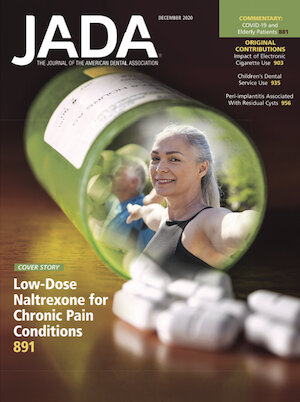Low-Dose Naltrexone Gaining Recognition as Chronic Pain Treatment
/By Pat Anson, PNN Editor
Low-dose naltrexone (LDN) is finally getting some recognition from the medical community as a treatment for chronic pain. The December edition of the Journal of the American Dental Association (JADA) features a cover story on the use of LDN by dentists – not to manage short term pain during dental procedures – but to treat chronic oral and facial pain conditions such as temporomandibular joint disorder (TMJ).
“Low-dose naltrexone provides an alternative in medical management of chronic pain disorders as a novel anti-inflammatory and immunomodulator. It can offer additional management options, as orofacial pain conditions share characteristics with other chronic pain disorders,” wrote Elizabeth Hatfield, DDS, corresponding author and clinical lecturer at the University of Michigan School of Dentistry.
Few mainstream medical organizations have recognized the benefits of naltrexone as a pain reliever, largely because the drug is only approved by the Food and Drug Administration as a treatment for substance abuse. In 50mg doses, naltrexone blocks opioid receptors in the brain and decreases the desire to take opiates or alcohol.
But in smaller doses of 5mg or less, patients with a wide variety of pain conditions have found LDN to be a surprisingly effective pain reliever. PNN columnists have shared their positive experiences using LDN to treat everything from interstitial cystitis to Ehlers-Danlos syndrome to fibromyalgia.
How naltrexone works is not exactly clear – more research is needed – but LDN supporters believe the drug helps modulate the immune system, reducing inflammation and stimulating the production of endorphins, the body's natural painkiller.
The lack of good quality research on LDN is evident in the JADA article. Hatfield and her colleagues reviewed nearly 800 studies, but could find only eight that met their criteria for evaluation, most of them focused on treating fibromyalgia. Nevertheless, they say LDN could be an effective and less risky alternative to opioids and non-steroidal anti-inflammatory drugs (NSAIDs) for treating chronic oral and facial pain.
"The unique antinociceptive properties mediated via glial cell modulation, as opposed to previously identified pathways of opioids and anti-inflammatories such as NSAIDs, is attractive as it bypasses certain side effects and concerns with long-term NSAID and opioid use," said Hatfield. "Further benefits include reduction in reported pain levels and measurable increases in quality of life for patients with chronic pain disorders. Additionally, it offers an option for prescribers managing temporomandibular joint disorders with a centralized pain component.”
A 2019 review by British researchers found that LDN is safe to use, but also recommended that more clinical studies be conducted on its potential uses.
Because naltrexone is only approved to treat addiction, LDN needs to be prescribed “off-label” for pain. Patients interested in trying LDN often encounter doctors who refuse to prescribe it or don’t know anything about it. The LDN Research Trust includes a list of LDN-friendly doctors and pharmacies on its website.




